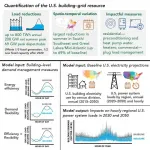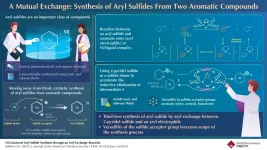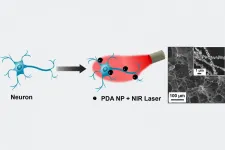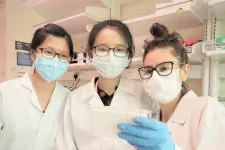Reaping the benefits: Training in rice growing system ups yields and well-being
Study shows randomized Bangladesh-based trial of training in agronomy method has advantages for rice output and profits, as well as for the rice farmers' lives
2021-07-21
(Press-News.org) Tsukuba, Japan - Rice is the world's most commonly grown and consumed crop. It also supports lives and livelihoods, especially in low- and middle-income regions. As such, methods for securing abundant and profitable rice harvests are key in global food security.
The System of Rice Intensification (SRI) offers a repeatable, sustainable system for increasing rice yields. It brings together fundamental planting and harvesting techniques such as strategically spacing plants, minimizing water, and transplanting seedlings. These practices can be repeated in varying conditions. While SRI has been around since the mid-1980s, need persists for evidence to back its merits and distinguish its techniques.
New findings published in the American Journal of Agricultural Economics now give much-needed evidence of SRI, following its diffusion to more than 5,000 Bangladeshi farmers. SRI training was introduced and evaluated among the rice farmers in a similar manner to a randomized controlled trial (RCT) in medicine. Certain communities were trained while others were not. This created a pure control group, similar to those who receive a placebo or receiving nothing in an RCT. That in turn allowed compelling comparisons, along with insights into related effects of the training.
Professor Abdul Malek of the University of Tsukuba (Japan), together with international colleagues including Asad Islam (Monash University), Christopher Barrett (Cornell University), Marcel Fafchamps (Stanford University), and Debayan Pakrashi (Indian Institute of Technology Kanpur), conducted these randomized introductions of SRI in Bangladesh and studied them from agricultural and social angles. The core of the researchers' work was two RCTs in 2014-2015 and 2015-2016.
"To a large degree, we already know SRI delivers good yields, among other advantages. Some have, however, questioned its uniqueness and results, so there is continued need for evidence to support it," Professor Malek says. "By randomizing a large cohort of farmers, we have been able to look at both SRI's quantifiable economic benefits and the qualitative benefits of disseminating this agronomic training and knowledge."
Among the results, SRI led to rice yield and profit increases of 14%-17% and 22%-31%, respectively. Household well-being was also found to be higher for farmers in training communities vs. those without training. Additionally, a spillover effect was seen as untrained farmers in training communities also gained exposure to SRI practices.
In two previous studies published as Fafchamps, etal (2021 and 2020) available at respectively: lhab009, https://doi.org/10.1093/wber/lhab009 and https://www.sciencedirect.com/science/article/pii/S0304387818314913
, Professor Malek and colleagues elaborated on these knock-on benefits of this training. His research teams used the trials to show (1) the efficacy of introductory referrals to training and (2) the cost advantages of peer-to-peer transmission of knowledge acquired. The latest work corroborates the overall findings in a broader scope to give valuable evidence of training and of SRI itself.
"We've covered a great deal of ground in verifying how SRI boosts productivity and farmers' well-being," Professor Malek says. "We've also seen how knowledge is transferred among trained farmers. This may help settle intense debates around SRI as a tool for boosting rice productivity and rice farmers' well-being. It also offers a great deal of promise for agronomy in the Global South."
INFORMATION:
The article, "Experimental Evidence on Adoption and Impact of the System of Rice Intensification," was published in the American Journal of Agricultural Economics at https://doi.org/10.1111/ajae.12245
This study and the previous two studies received two successive grants from the International Growth Centre (grant numbers 1-VCA-VBAN-VXXXX-3111 and 1-VRC-VBGD-VXXXX-89309). Support was provided for field work, training, and surveys that were conducted by BRAC. The authors declare no competing interests.
[Attachments] See images for this press release:

ELSE PRESS RELEASES FROM THIS DATE:
2021-07-21
Since buildings consume 75% of electricity in the U.S., they offer great potential for saving energy and reducing the demands on our rapidly changing electric grid. But how much, where, and through which strategies could better management of building energy use actually impact the electricity system?
A comprehensive new study led by researchers from the Department of Energy's Lawrence Berkeley National Laboratory (Berkeley Lab) answers these questions, quantifying what can be done to make buildings more energy efficient and flexible in granular detail by both time (including time of day and year) and space (looking at regions across the U.S.). The research team, which also included scientists from the National Renewable Energy Laboratory (NREL), found that ...
2021-07-21
Aryl sulfide, an aromatic compound in which sulfur is attached to an aryl (a functional group derived from an aromatic ring), is found in biologically active materials effective against asthma, Alzheimer's disease, and cancer. As a result, chemists have shown a lot of interest in synthesizing aryl sulfides. Traditionally, carbon-sulfur (C-S) bond formation reactions between thiols and aryl electrophiles catalyzed by transition metals have been employed for aryl sulfide synthesis because of their high reliability. However, thiols have an unpleasant smell and are toxic. Could there be a way to synthesize aryl sulfides that avoids the ...
2021-07-21
A new study of almost 12,000 Australians has found one-third of the adult population has experienced pure cybercrime during their lifetime, with 14% reporting this disruption to network systems in the past 12 months.
With all forms of cybercrime already costing trillions every year globally, experts from the Australian Institute of Criminology (AIC) and Flinders University say the crimes involved substantial levels of personal victimisation including direct losses as well as the high cost of preventing future attacks.
A pre-COVID-19 snapshot of the cost of 'pure cybercrime' in 2019 has found an approximate ...
2021-07-21
Nanomaterials have been used in a variety of emerging applications, such as in targeted pharmaceuticals or to bolster other materials and products such as sensors and energy harvesting and storage devices. A team in the McKelvey School of Engineering at Washington University in St. Louis is using nanoparticles as heaters to manipulate the electrical activity of neurons in the brain and of cardiomyocytes in the heart.
The findings, published July 3, 2021, in Advanced Materials, have the potential to be translated to other types of excitable cells and serve as a valuable tool in nano-neuroengineering.
Srikanth Singamaneni, a materials scientist, and Barani Raman, a biomedical engineer, and their teams collaborated to develop a noninvasive technology that inhibits the electrical ...
2021-07-21
It's hard to save what you can't identify. That's been a problem for the endangered salt marsh harvest mouse, which is found only in the salty, brackish waters of the San Francisco Bay area. The mouse competes for space with about eight million humans, and more than three-quarters of its habitat has been eaten by development and land conversion. That loss is expected to increase amid rising sea levels.
Conserving the population has proven tricky, in part because it looks so much like another mouse in the area--the western harvest mouse--that is abundant throughout western U.S.
But scientists from UC Davis have developed a tool, a "decision ...
2021-07-21
Researchers from the Antimicrobial Resistance (AMR) Interdisciplinary Research Group (IRG) at Singapore-MIT Alliance for Research and Technology (SMART), MIT's research enterprise in Singapore, alongside collaborators from Biobot Analytics, Nanyang Technological University (NTU) and Massachusetts Institute of Technology (MIT), have successfully developed an innovative, open-source molecular detection method that is able to detect and quantify the B.1.1.7 (Alpha) variant of SARS-CoV-2. The breakthrough paves the way for rapid, inexpensive surveillance of other SARS-CoV-2 variants in wastewater.
As the world continues to battle and contain COVID-19, the recent identification of SARS-CoV-2 variants with higher transmissibility and increased severity has made the development ...
2021-07-21
COLUMBUS, Ohio - The parasites that cause severe malaria are well-known for the sinister ways they infect humans, but new research may lead to drugs that could block one of their most reliable weapons: interference with the immune response.
In the study, scientists defined the atomic-level architecture of the connection between a protein on the surface of a parasite-infected red blood cell when it binds to a receptor on the surface of an immune cell.
When that protein-receptor connection is made under normal circumstances, the infected red blood cell, hijacked by the disease-causing parasite, de-activates the immune cell - meaning the body won't fight the infection. A drug designed to fit into that space could block the interaction, allowing the immune system to get to work clearing ...
2021-07-21
LA JOLLA, CA--You can't make a banana split without bananas. And you can't generate stable regulatory T cells without Vitamin C or enzymes called TET proteins, it appears.
Regulatory T cells (Tregs) help control inflammation and autoimmunity in the body. Tregs are so important, in fact, that scientists are working to generate stable induced Tregs (iTregs) in vitro for use as treatments for autoimmune diseases as well as rejection to transplanted organs. Unfortunately, it has proven difficult to find the right molecular ingredients to induce stable iTregs.
Now scientists at La Jolla Institute for Immunology ...
2021-07-21
DALLAS, July 21, 2021 -- Babies who were breastfed, even for a few days, had lower blood pressure as toddlers and these differences in blood pressure may translate into improved heart and vascular health as adults, according to new research published today in the Journal of the American Heart Association, an open access journal of the American Heart Association.
Research has found that cardiovascular disease risk factors, including high blood pressure, can start in childhood. Studies have also confirmed breastfeeding is associated with lower cardiovascular disease risk in adulthood. However, the amount and length of time breastfeeding that is needed ...
2021-07-21
DALLAS, July 21, 2021 -- People who made even small increases in their daily physical activity levels after receiving an implantable cardioverter defibrillator (ICD) experienced fewer incidences of hospitalization and had a decreased risk of death, according to new research published today in Circulation: Cardiovascular Quality and Outcomes, an American Heart Association journal.
Implantable cardioverter defibrillators, also known as ICDs, are battery-powered devices placed under the skin that can detect abnormal heart rhythms and deliver an electric shock to restore a normal heartbeat. According to American Heart Association's Heart Disease ...
LAST 30 PRESS RELEASES:
[Press-News.org] Reaping the benefits: Training in rice growing system ups yields and well-being
Study shows randomized Bangladesh-based trial of training in agronomy method has advantages for rice output and profits, as well as for the rice farmers' lives






